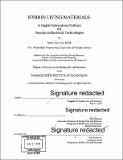Hybrid Living Materials : a digital fabrication platform for functional bacterial technologies
Author(s)
Smith, Rachel Soo Hoo.
Download1108654460-MIT.pdf (18.68Mb)
Alternative title
HLMs : a digital fabrication platform for functional bacterial technologies
Digital fabrication platform for functional bacterial technologies
Other Contributors
Program in Media Arts and Sciences (Massachusetts Institute of Technology)
Advisor
Neri Oxman.
Terms of use
Metadata
Show full item recordAbstract
Hybrid Living Materials (HLMs) are formed by combining living and non-living materials such that the new material takes on the properties of both. Yet, the integrated control of both material and biological properties and their interactions remains challenging due to the complexity of natural constructs and the lack of standardized infrastructure to control biological function in 3D space. The state of the art remains limited in its range of scale and application scope. We seek to extend the conventions used for the digital design and fabrication of human-made structural materials to harness valuable biotic functionalities-such as sense, response, growth, metabolization, and even adaptation-to enable a diverse new class of multifunctional materials. This thesis establishes a generalizable framework and technical workflow for the creation of HLMs. The approach integrates (i) computational design, (ii) digital fabrication, and (iii) synthetic biology to generate materials that are programmed to host and template engineered bacterial cells. Specifically, this research employs a multimaterial 3D printing platform in combination with newly developed biochemical signaling resins and volumetric modeling tools to produce additively manufactured objects containing high resolution bioactive diffusion gradients. Computer aided design (CAD) tools allow multiple genetic regulatory signals to be precisely positioned within the cured architectures of these printed shapes. When combined with hydrogel immobilization methods to sustain E. coli and facilitate biosignal transmission on these objects, this approach achieves spatial genetic regulatory control of engineered cells across complex geometries and produces functional hybrid-living materials. Importantly, the HLM fabrication platform achieves living constructs of up to half a meter in length, and accurate simulation of executable biological patterning and outputs. The platform provides design and fabrication tools that advance the merger between digital manufacturing and biological engineering for a unique level of control and repeatability over spatially-varying material properties and cellular function. Thus, the methodology, hardware, and computational design space established provide an entry point for designers, engineers, and scientists to mediate bacterial functionalities with material technology for broad application.
Description
Thesis: S.M., Massachusetts Institute of Technology, School of Architecture and Planning, Program in Media Arts and Sciences, 2018 Cataloged from PDF version of thesis. Includes bibliographical references (pages 133-141).
Date issued
2018Department
Program in Media Arts and Sciences (Massachusetts Institute of Technology)Publisher
Massachusetts Institute of Technology
Keywords
Program in Media Arts and Sciences